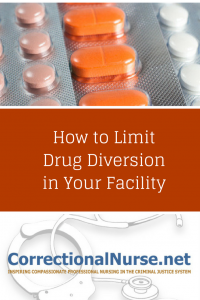Guest post by Sherley Alaba:
As a correctional nurse, you’ll likely experience times where prisoners seek specific medications for their own uses. Many prescription drugs are of great value in the prison economy. Also, plenty in the incarcerated population have issues with substance abuse. When illegal substances are out of reach, prescription drugs provide a way to get a ‘fix’. Others use prescription drugs to deal with the boredom and anxiety that comes with being locked up.
Here are some ways to limit diversion of prescription drugs in your facility.
Implement Restrictions
Diversion of prescription drugs can be avoided with rules on what prescription drugs were allowed into the facility. However, this solution isn’t the most effective because banning one drug can cause inmates to seek out the ones that are not banned.
You can enforce greater restrictions on when the medication is actually prescribed to an inmate. Give the medication only after seeing all the medical indicators and determining whether the medication is absolutely needed.
A medication formulary is a helpful way to limit high abuse potential medications.
Medication Format
When possible, administer high-abuse drugs in formats that limit the chance of diversion. For example, instead of providing drugs in pill form, liquid form or as injections. Both limit the potential for ‘cheeking’ or ‘palming’ the medication for other uses.There are challenges with this method too, as changing the form of medication can be a hassle. It can increase the cost of the medication itself and it will likely take longer to administer. Changing the form of drugs can also affect effectiveness. “Crushing and floating” medication is used in some correctional settings but this method has some concerns to monitor.
Increase Communication
Everyone involved in handling the medication including nurses, providers, and custody staff need to know the repercussions of the medication diversion and take ownership of their roles.
The process of administering the medication needs to be organized, monitoring ingestion of medication and closely observing the inmate’s health.
Officers need to keep an eye out for incidents of coercion and diversion. Nurses need to work with correctional officers if they suspect that an inmate may be involved in diversion. Officers can also conduct random cell searches to check for drugs.
Patient Assessment and Care
Nurses should observe inmates closely and look for indications of previous drug use. If an inmate has been a substance abuser in the past, they are more likely to participate in drug diversion and trading while incarcerated. Nurses have an opportunity to implement programs that help inmates cope with withdrawal, teach them coping skills and help them through recovery.
How about you? What do you do in your facility to limit drug diversion? Share your thoughts in the comments section of this post.
Author Bio:
Sherley Alaba is an eagle-eyed wordsmith; a writer and translator, always interested in ways which can help individuals (especially youth and women) reach their full creative potential. Her focus has been on writing, producing and editing stories on business, finance, interesting personalities, entrepreneurs, culture, the environment, gastronomy, lifestyle, and social issues. Currently she is associated as a blogger with Centracare Pediatrics.

Sky says
Great post and very informative.
Gayle Burrow says
It always comes down to observation/assessment and communication. What nursing is all about.
Thanks for the post to remind us.
Sheila Miller, RN says
We no longer float crushed medications. We mix them with about 2 tablespoons of applesauce. This allows the medication to be thoroughly mixed with the applesauce and makes it extremely difficult for the patient to “strain” through her/his teeth. This is a method used by rehabilitation nurses for those with swallowing difficulties.
Also, we do not use extended release medications, which allows us to crush many more medications if needed.